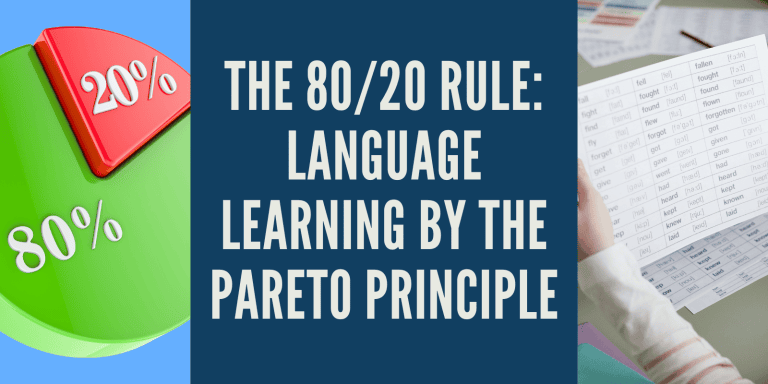Rocket Spanish Review 2025: Does This Course Work?
If you’re looking for a detailed and honest Rocket Spanish review, you’ve come to the right place.
Rocket Spanish (part of the Rocket Languages group) may not have the same hype as other apps. But it’s a comprehensive course with audio, grammar, and cultural lessons designed to help you speak fluently.
So does it really help you learn Spanish?

Rocket Spanish Review 2025
Rocket Spanish is one of the most complete online language courses available. The lessons are structured, the audio and role-play build real speaking confidence, and it takes you step by step from beginner to advanced. With clear grammar and useful vocabulary, the price feels justified.
Pros
Cons
You can use the Table of Contents to skip ahead, depending on what you want from this Rocket Spanish review. Or just keep reading for the full picture.
Rocket Spanish may not be as well-known as Duolingo or Rosetta Stone, but it has built a loyal following over the years. That was enough to make me want to test it out for myself and share the honest pros and cons here.
Before we get started, it’s worth noting that you can sign up for the Rocket Spanish free trial – no credit card needed – which gives you access to the first two modules. That way, you can follow along with the features as I mention them in this review.

What Is Rocket Spanish?
Rocket Spanish is part of the broader Rocket Languages courses, an online platform founded in New Zealand in 2004. Rocket Languages focuses on practical, spoken communication and covers multiple languages. But Spanish is their flagship course and most popular.
This course is divided into three levels: Level 1 (beginner), Level 2 (intermediate), and Level 3 (advanced).
The content mixes interactive audio lessons with language and culture modules, along with clear grammar and vocabulary explanations. So you’re not only repeating phrases out of context.
The default target is Latin American Spanish, which is ideal for most learners. However, if you prefer European Spanish, you’ll still be able to follow everything, but there are some minor differences in vocabulary and pronunciation.
In short, it’s a structured path with extensive and practical lessons with a Latin American focus.
If you’ve tried gamified apps before and want something that feels like a complete, comprehensive course, taking you from beginner to advanced, this is what Rocket’s aiming to provide.
How the Rocket Spanish Course Works
The Interactive Audio Lessons
The backbone of Rocket Spanish is definitely the interactive audio lessons. They take, on average, between 20 and 30 minutes each and have a podcast feel.
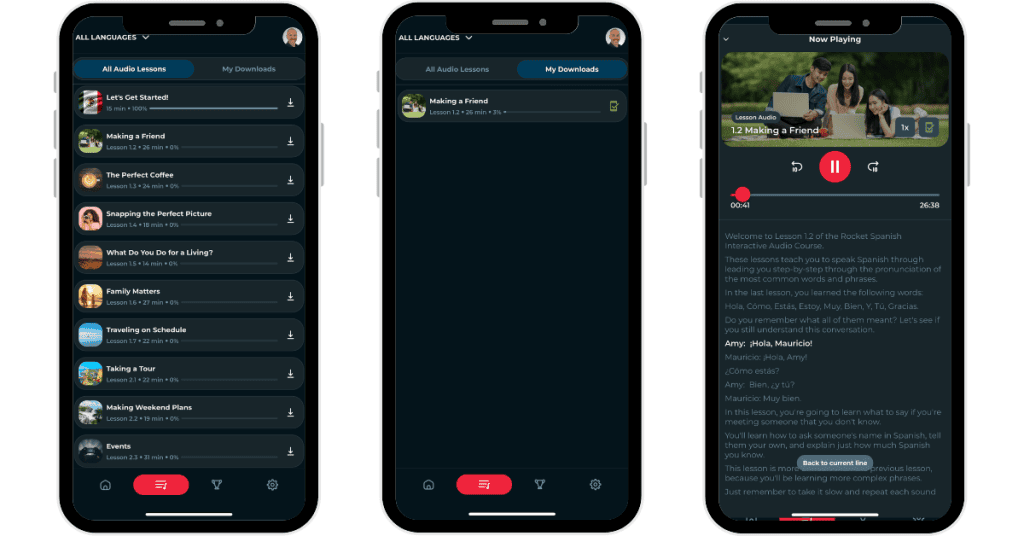
You have native Spanish speakers guiding you through real conversations, with the English-speaking host (from the United States) giving a clear explanation of what’s happening. I like this as you are listening to actual conversations – part of the class – while also receiving advice from the “teacher” about common mistakes or things to pay attention to.
Another thing I really liked is that the voices aren’t robotic or overly polished. They are clear, with a natural tone and even some humour.
I’ve used other apps where the audio was either AI-generated or phrases recorded in isolation. Here, you repeat phrases and role-play the conversations with the native speakers. By the end of an audio lesson, you’ve rehearsed a whole conversation.
The best part for me is that it forces you to speak Spanish out loud (which is scientifically more effective when learning). It’s very easy to “study silently” but then freeze in a real-life conversation.
Here, you can improve your speaking skills, pronunciation, and confidence from the very start. Which will help you achieve Spanish fluency more quickly.
The Language and Culture Lessons
Now, the audio lessons are great, but they’re only part of the package.
Rocket Spanish also gives you dedicated language and culture lessons, which include grammar lessons.

Some apps often lack clear grammar lessons. But Rocket’s explanations are surprisingly clear and short. You don’t get the feeling you need a PhD in linguistics to figure out verb conjugations.
They also weave in cultural lessons (mostly about Latin America). For example, greetings in Mexico versus those in Argentina, and so on. Useful background info if you’re preparing for a trip.
That said, if you’re preparing a trip to Spain, you might feel a tiny gap here. The course focuses on Latin America, and while the grammar is largely the same, some vocabulary and expressions may not always align. But it’s not a big deal – it’s similar to the differences between British English and American English.
Supplemental Drills and Reinforcement
After the audio and grammar, you get to the drills. This is where the Rocket Spanish program provides you with short, active exercises that you can use for daily practice.

You have flashcards, quizzes, writing drills, and listen-and-repeat exercises. I’m a big fan of flashcards in general. And here you grade yourself (Easy, Good, Hard), so you can be honest about what you know and what you don’t.
This helps you build your Spanish vocabulary as you only complete the task when you feel comfortable with it.
Then you have the writing drills. From my experience as a teacher, I have found that this is the one skill that most people tend to skip when learning a new language. Being phonetic, the Spanish language is not difficult to write, but these exercises are scored, and they’ll deduct points if you don’t use the accents (ie, sabado instead of sábado).
After that are the speaking activities, where you repeat after the native speakers. These are simple to do on the mobile app. In fact, switching between mobile and computer is easy, so you’re not stuck on one device (I usually prefer to do writing tasks on my computer).
Finally, there’s a leaderboard and points system built into all of this. The leaderboard is not a deal-breaker for me in an app, but I do find myself checking it out of curiosity and self-satisfaction.
Rocket Record: Voice Recognition Software
Rocket Spanish puts a strong emphasis on speaking and pronunciation.
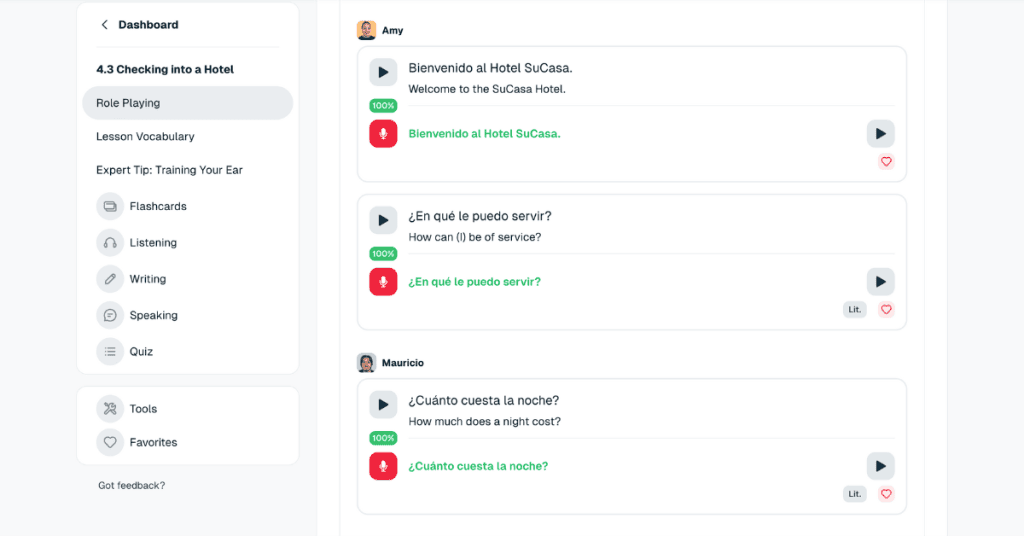
It uses its tool called Rocket Record, which is powered by Google’s voice recognition software. So it is a well-developed and sound piece of technology.
You have to immediately repeat phrases after hearing the native speaker say them, and I like that you can then listen to yourself back.
This is a great feature as it’s only when you hear yourself speak (most people hate this, but it’s so important) that you can really perfect your pronunciation. It forces you to assess yourself speaking Spanish and refine your accent.
Focusing on pronunciation and building your confidence from the start is something I highly recommend. You will become conversationally fluent more quickly (plus people tend to forgive grammar mistakes if you make them with a convincing accent).
I would say Rocket Record works really well and is useful, so definitely make the most of this feature.
App, Interface, and User Experience
The Mobile App
The Rocket Spanish program comes with a free iOS and Android app (as you’d expect in 2025).
It syncs automatically with your account, so you can easily switch between devices.

An excellent feature is the ability to use it offline. You can download lessons ahead of time, which makes it handy on flights, trains, or when Wi-Fi is limited. Many other language apps require an internet connection at all times.
Compared to competitors, the app design is simple. You won’t find bright animations or gamified characters pushing you along. Instead, it’s stripped back and functional, which helps you focus more on the material than on visual distractions.
The New Dashboard Interface
The dashboard has recently been updated, pulling everything together into one place.
You can see the entire course laid out clearly, and each lesson turns green as you progress. It feels linear, like working through a structured textbook. But with the benefit of interactive tools.

The interface is more text-heavy than some other language apps. It might look plain compared to competitors that provide lots of colour and animations. But I found this keeps the Rocket Lessons organised and easy to navigate, without a style-over-substance problem.
Navigation is fast, the menus are clean, and you don’t waste time digging through hidden tabs. Everything you need – audio, grammar, drills – is right there on the main dashboard. It makes learning straightforward.
Rocket Spanish Cost
Standard Pricing
The cost of the Rocket Spanish program is simple and transparent.

| Level 1 | $149.95 |
| Level 1 and 2 | $299.90 |
| Levels 1, 2 and 3 (Complete Spanish Course) | $449.85 |
You can also purchase Level 2 or Level 3 on their own, which is helpful if you already have some knowledge of Spanish. The price for an individual level is $149.95.
Here’s what’s included in with each plan:
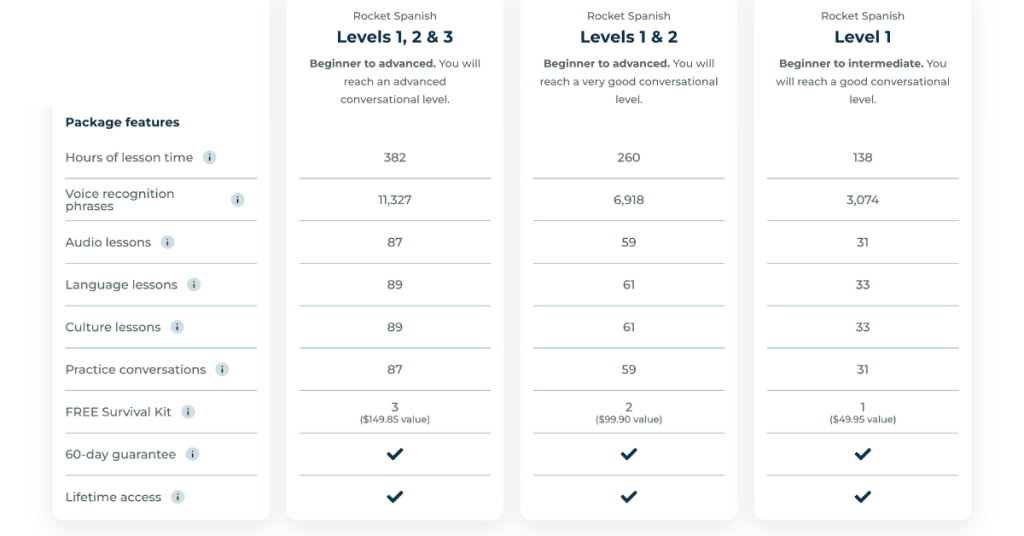
For the top tier (Levels 1–3), there’s an option to split the payment into six monthly instalments of $75, instead of paying the entire amount upfront.
Discounts and Refund Policy
A few times a year, Rocket Spanish runs a promotion offering a discount of up to 60%. So, if you can’t afford to pay the full price, it’s worth keeping an eye out for one of these offers.
You also have a 60-day money-back guarantee. That gives you the peace of mind that if you are not enjoying the course within the first two months, you can get a full refund. This is more generous than most other programs, which typically offer only 30 days.
However, as I mentioned earlier, you have the Rocket Spanish free trial. This should be enough content to know exactly what you’re getting before you buy. The trial gives you access to the first two modules of the course, which is a good test drive.
Add-Ons: Travelogue and Play the Part
There are also a couple of add-on products you can buy.
The first option is the Rocket Spanish Travelogue for $149.95

The Travelogue includes more than 3,000 travel-focused phrases, which are presented in complete lessons. This is a good option if you’re planning a trip and want new vocabulary and the same phrases you’ll actually use at airports, restaurants, or hotels.
Then there’s Play the Part. This course, also $149.95, is designed for advanced learners who already have a solid foundation in the Spanish language and wish to prepare for real-life situations when visiting Mexico.
The focus is less on grammar and more on cultural lessons and everyday conversation, so you can start speaking Spanish the way locals do immediately.
Both of these extras are separate from the standard Rocket Spanish program. They won’t be necessary for everyone, but they’re a good option if you’re planning a trip and want to engage in more authentic conversations.
Strengths of the Rocket Spanish Program
Comprehensive Spanish Course
I really think Rocket Spanish feels like a proper Spanish course.
It’s not just random, out-of-context sentences, or focused on daily streaks. Instead, it guides you through a structured Spanish learning experience, covering grammar, vocabulary, culture, and conversation in a consistent and cohesive path.
I believe that speaking and pronunciation focus are absolutely necessary in all language lessons.
If you get frustrated trying to balance different language learning apps and books, this is a good option for you. It’s a comprehensive, all-in-one Spanish program. If you work through it step by step, you will cover all the learning essentials without gaps.
Audio Lessons
The audio lessons are what make this more than a practice app.
They remind me a bit of Pimsleur, as both are heavily focused on spoken practice and actual conversation. However, Rocket Spanish takes it a step further by combining interactive audio with follow-up drills.
In the interactive audio lessons, you have to repeat phrases and role-play parts of a conversation. I like this as it forces you to engage, which is what makes it very effective for improving real-life communication skills.
Clear Grammar Explanations
Another strength is the grammar explanations.

I’ve seen plenty of grammar lessons that either overcomplicate things or provide barely any explanation at all. Rocket Spanish hits a nice middle ground. The explanations are clear and concise without being overly boring.
This balance keeps you moving forward without feeling stuck in endless grammar rules.
Offline Access to All the Material
One of the big pluses of Rocket Spanish is offline access.
You can download MP3s of the audio lessons to your mobile, allowing you to listen to them on flights or abroad without relying on an internet connection.
I found this really useful when travelling. Even without Wi-Fi or Data Roaming, I could still listen to the course without interruption. It’s simple, but it adds real value.
You also have lifetime access to the course, including any updates and improvements.
Forum and Community
Rocket Spanish also has a community built into the platform.
There’s a forum where you can post questions and interact with other learners, which gives you a sense of not studying alone.
To be honest, there isn’t much activity in the Rocket Spanish forum. But there’s nothing stopping you from going in and creating a new discussion topic or asking questions.
As with most of these apps, there are daily streaks, a points system, and a leaderboard. This ties into the community feel, if you like that in a course.
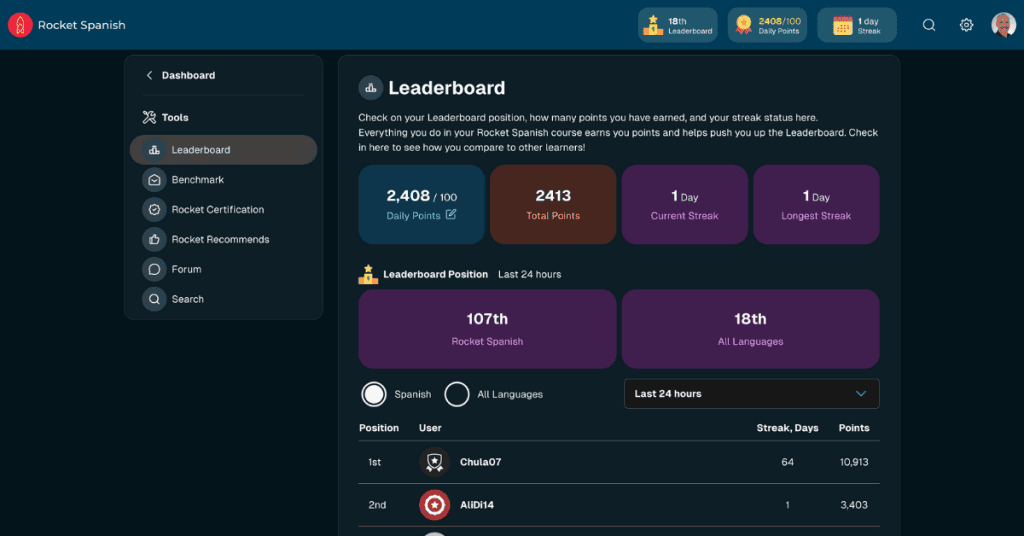
I like that it’s not too “in your face”, but I can still enjoy the satisfaction of seeing myself moving up the board. It’s not the same as full gamification, but it adds accountability and encouragement.
Weaknesses of the Rocket Spanish Course
Lessons Can Be Long
The complete lessons take commitment.
Between the interactive audio and the follow-up drills, each module can easily stretch to about an hour.
For some people, the length is a strength because it feels like a proper class. But if you prefer short daily bursts, the pacing of Rocket Spanish may feel heavy.
Limited Visuals
Rocket Spanish isn’t built for visual learners.
The program uses a lot of text and audio, but very few images. If you need visuals to connect with individual words or concepts, it can feel a bit dry.
Compared to language learning apps that lean heavily on visuals, Rocket takes a more old-school approach.
No Driving Mode
One complaint I’ve seen online is that there is no driving mode.
Pimsleur offers hands-free lessons designed for listening while you’re on the road. But Rocket Spanish doesn’t have that option.
However, as the lessons are audio-based (and you can download the MP3s through the app), nothing is stopping you from listening to the audio lessons in your car while driving.
Rigid Learning Style
Rocket Spanish follows a very structured, linear path.
For some learners, that’s perfect, because it keeps you organised. But others might feel boxed in if they like to jump around or explore in a less rigid style.
The course structure works well if you want clear direction. But if you prefer freedom to jump around lessons, Rocket might feel a little strict.
Latin American Spanish vs European Spanish
Rocket Spanish is built around Latin American Spanish.
That makes sense because most Spanish speakers worldwide are from Latin America. The vocabulary, pronunciation, and cultural notes all reflect that side of the language.
However, I learned Spanish in Spain, and I had absolutely no issues using Rocket Spanish. The voice recognition software accepted my Castilian Spanish pronunciation.
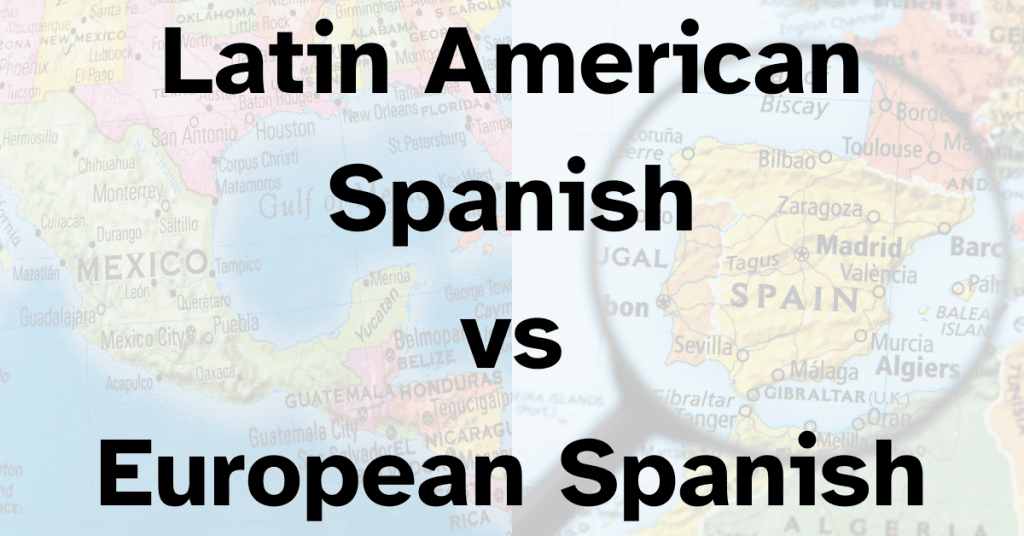
The differences between European Spanish and Latin American Spanish are mostly small things, such as vocabulary (think British English vs. American English), or the “th” sound in words like cena.
But in practice, Spanish speakers from both sides of the Atlantic understand each other perfectly. You notice the variations, but it doesn’t make any difference to communication.
Who Is Rocket Spanish Best For?
Rocket Spanish works really well for new learners who need structure.
If your learning style benefits from having a clear path – lesson one, then lesson two, and so on – this program delivers that.
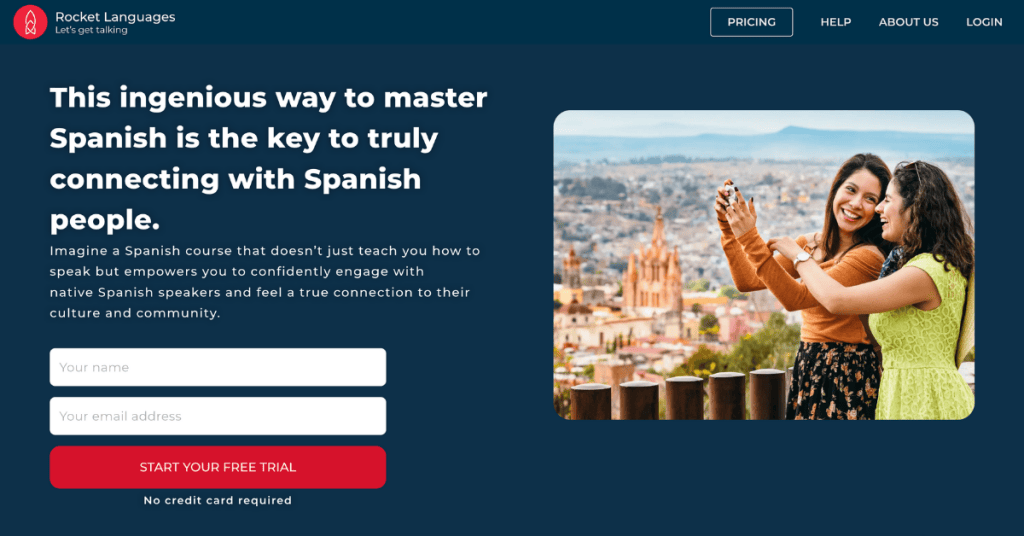
It’s also a solid choice if you’re serious about building long-term skills and want language learning resources that cover listening practice with native speakers and clear grammar explanations.
Plus, your future self will really thank you for the speaking and pronunciation practice early on.
The language and culture lessons are also useful for travellers. You can focus on the audio lessons and role-play real conversations that you’ll actually need in restaurants, hotels, or airports. That mix of speaking practice and cultural notes makes it easier to feel confident when you’re abroad.
On the other hand, Rocket Spanish might not be the best fit for visual learners. There aren’t many images, so if you need heavy visuals or game-like features, it won’t click the same way.
Nor is it ideal for casual users who just want to play around with a language app for five minutes a day.
How Rocket Languages Compares to Other Language Apps
Rocket Spanish vs Duolingo
Duolingo is more casual and gamified, so yes, it is fun for quick daily practice.
However, Rocket Spanish goes much deeper. The focus is more on structured lessons to help you learn Spanish than on collecting points from short quizzes.
Rocket Spanish vs Rosetta Stone
Rosetta Stone is well known for its visual immersion approach.
Rocket Spanish focuses more on audio lessons and grammar details, which makes it easier to understand why phrases work the way they do. Compared to other courses, it blends conversation with clear rules, rather than relying only on pictures.
Rocket Spanish vs Pimsleur
Both Rocket Spanish and Pimsleur are audio-heavy.
The difference is that Rocket explains the grammar principles, includes drills, and allows users to download the audio lessons as MP3s. That sense of ownership makes Rocket feel more like a full course than just a listening program.
Rocket Spanish vs Babbel & Busuu
Babbel and Busuu are designed around short, snack-sized lessons.
Rocket Spanish feels more like a comprehensive Spanish program, aimed at learners who want a structured path rather than just a few minutes of daily practice.
My Experience with Rocket Spanish
From my own experience, I’ve really grown to love the style of Rocket Languages.
The linear, step-by-step structure works perfectly for my learning style. It feels like a real language course rather than a collection of random activities. And as a teacher, I appreciate how clear and consistent that structure is.
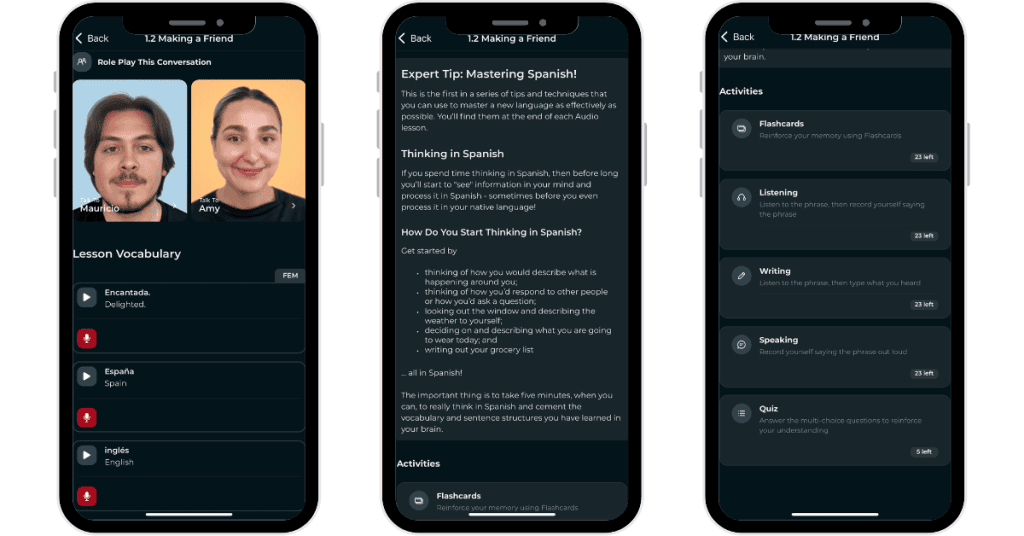
The grammar explanations stood out to me. They’re short and practical, and they make sense in context.
I’ve used other apps where you end up just writing and repeating random sentences that don’t connect, and honestly, that never stuck for me. Rocket Languages keeps the grammar tied to real communication, which is how it should be taught.
I also found the pronunciation work really strong. The audio recordings, role-play dialogues, and the ability to listen to yourself back are excellent tools. Most people hate hearing their own voice, but it’s exactly what you need to refine pronunciation.
From a teaching perspective, getting Spanish pronunciation right early builds the confidence to keep speaking later, even if your grammar isn’t perfect yet.
The drills and speaking activities tie in well with modern language-learning science. Spaced repetition, self-evaluation, and immediate feedback keep the practice active, not passive.
Some parts of Rocket Languages are a bit text-heavy, but overall, I found the balance between explanation and practice to be very effective.
Is Rocket Spanish Worth It?
Yes. In my opinion, Rocket Spanish is worth it if you’re serious about learning Spanish.

The content is extensive, allowing you to start as a complete beginner and progress all the way to an advanced level. That makes the rocket course more expensive than some other apps, but you’re getting far more material.
In that sense, Rocket Spanish is good value for money.
The strengths are clear: structured lessons, strong grammar explanations, and a big emphasis on pronunciation and speaking exercises.
The weaknesses (longer lessons, fewer visuals, and a rigid style) are not too important if what you want is a proper language course. If you’re looking for a gamified app to play with in your free time, Rocket Spanish might not be the best fit.
However, if you prefer a clear, linear path that teaches you to communicate effectively, then Rocket Languages is a good option. It’s one of the few programs I’ve tried where language learning actually feels like the core of the program. And not just to keep you entertained for five minutes a day.
FAQ
How much does Rocket Spanish cost?
The standard price for Rocket Spanish is $149.95 per level if bought separately. If you buy Levels 1 and 2 together, it’s $299.90, and the whole course (Levels 1 to 3) is $449.85.
There are often discounts of 50–60%, which makes the cost of Rocket Spanish more affordable. It’s worth keeping an eye out for offers if you’re on a budget.
Does Rocket Spanish really work?
Yes, if you use it regularly and follow the course.
Rocket Spanish utilizes interactive audio lessons, grammar explanations, and speaking exercises that build all four skills: listening, speaking, reading, and writing. It’s not magic, but it’s a structured path that works well if you stick with it.
Is there a Rocket Spanish free trial?
Yes. The Rocket Spanish free trial gives you full access to the first two modules of the program. No credit card is needed to sign up. It’s enough to get a feel for the audio lessons, drills, and cultural notes, and to see whether the style suits your learning.
Can you learn European Spanish with it?
Rocket Languages has built this course around Latin American Spanish, but European Spanish learners can still benefit from it.
The grammar is similar, and the differences are mostly in vocabulary and accent. I learned Spanish in Spain and had no issues with Rocket Spanish at all. The voice recognition software accepts Castilian pronunciation.
How long does it take to complete the whole course?
That depends on your pace. If you study a lesson every day, you could finish the course (Levels 1–3) in under a year.
But most learners spread it out and take longer, especially if they repeat lessons or spend extra time practising outside the program.





